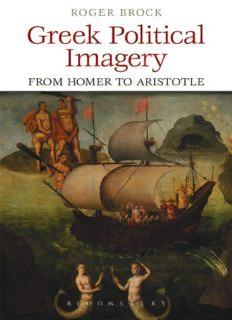Table Of ContentGreek Political Imagery from Homer to Aristotle
Greek Political Imagery
from Homer to Aristotle
Roger Brock
Bloomsbury Academic
An imprint of Bloomsbury Publishing Plc
50 Bedford Square 175 Fifth Avenue
London New York
WC1B 3DP NY 10010
UK USA
www.bloomsbury.com
First published 2013
© 2013 Roger Brock
All rights reserved. No part of this publication may be reproduced or transmitted in
any form or by any means, electronic or mechanical, including photocopying, recording,
or any information storage or retrieval system, without prior permission in writing from
the publishers.
Roger Brock has asserted his right under the Copyright, Designs and Patents Act, 1988,
to be identified as Author of this work.
No responsibility for loss caused to any individual or organization acting on or refraining
from action as a result of the material in this publication can be accepted by Bloomsbury
Academic or the author.
British Library Cataloguing-in-Publication Data
A catalogue record for this book is available from the British Library.
ISBN: 978-1-47250-218-6
Library of Congress Cataloging-in-Publication Data
Brock, Roger.
Greek political imagery from Homer to Aristotle / Roger Brock.
pages cm
Includes bibliographical references and index.
ISBN 978-1-78093-206-4 (hardback) -- ISBN 978-1-4725-0217-9 (epub) -- ISBN 978-1-4725-
0218-6 (epdf) 1. Greek literature--History and criticism. 2. Classical literature--History
and criticism. 3. Politics in literature. 4. Politics and literature--Greece. 5. Imagery
(Psychology)--Political aspects. 6. Greece--Politics and government--Early works to 1800. I.
Title.
PA3015.P63B76 2013
880.9'358--dc23
2013000816
Typeset by Fakenham Prepress Solutions, Fakenham, Norfolk NR21 8NN
Contents
Conventions vii
Acknowledgements ix
Introduction xi
1 Gods as Kings, Kings as Gods 1
2 The State as a Household and Family 25
3 The Shepherd of the People 43
4 The Ship of State 53
5 The Body Politic 69
6 Leaders and Communities: The Archaic Period (c.750–480 bc) 83
7 Democracy and Autocracy: The Fifth Century (c.480–404 bc) 107
8 Orators and Philosophers: The Fourth Century to Alexander (c.400–322 bc) 147
Epilogue 197
Bibliography 199
Index of Authors and Images 221
Index locorum 227
General Index 249
Conventions
Abbreviations generally follow LSJ and OLD for authors, and OCD3 for epigraphy and
papyrology; note additionally R&O = Rhodes & Osborne (2003) and P-W = Parke &
Wormell (1956). Fragments of tragedy are cited from TrGF, of comedy from PCG: in
the latter case ‘KA’ normally refers to the critical notes of Kassel & Austin. Fragments
of lyric poetry follow the numeration of PMG, while for iambus and elegy I follow
West; fragments of Pindar are cited from Maehler’s edition.
Acknowledgements
This book has been a long time in the making, though I believe that it is all the better
for it: in the long period of its gestation I have incurred many debts, and it is a great
pleasure now to able to express my gratitude for the assistance I have received from the
generous and collegial community of Classics. My only regret is that some of those to
whom I am indebted are no longer alive to see the project completed.
It began life as an Oxford DPhil thesis, ‘Political imagery in Greek literature before
Plato’: the topic was suggested to me by Oswyn Murray and the thesis was supervised
by George Forrest and Kenneth Dover, and examined by Tom Stinton and John Gould.
The award of the Derby Scholarship, for which I again thank the Derby Trustees and
the Craven Committee at Oxford, also enabled me to spend a rewarding academic
year in Toronto, where I benefited from the advice of Desmond Conacher, Leonard
Woodbury, John Cole and Mac Wallace. In the following year I was a Postdoctoral
Fellow at the Ohio State University, where I began the extension of the period covered
to the rest of the fourth century and enjoyed the company and generous hospitality
of the postgraduate community and academic staff, especially Charles Babcock, Carl
Schlam, Joe Tebben and my adviser David Hahm.
Thereafter progress was slowed by the lack of uncluttered time in which to be able
to reorganize all of the great mass of material into its final form: in the event, in the
absence of any institutional sabbatical leave provision this was only made possible by
the award of a Leverhulme Research Fellowship in 2002–3 and of a British Academy
Senior Research Fellowship in 2008–9. I am profoundly grateful to both organisations,
without whose support the book would not yet have seen the light of day even now.
I was able to try out earlier versions of the content and ideas on audiences in
Cambridge, Columbus, Edinburgh, Exeter, Hull, Lampeter, Leeds, Liverpool, London,
Manchester, Oxford, Rennes, Rethymnon, St. Andrews, Sheffield and Toronto, and I
thank the organisers in each case for the opportunity and the audiences for comments,
criticisms and suggestions which have improved my thinking. I have also benefited
over the years from the assistance of a great many individuals who have helped me
with encouragement and advocacy, provided advice and guidance, given me access to
inaccessible, unpublished or forthcoming work, answered questions, and otherwise
supported me. After all this time there will inevitably be some whose names are
omitted here, but however fallible my memory, I am sincerely grateful to all those who
have assisted me in any way. In particular I should like to thank Umberto Bultrighini,
John Davies, Kyle Erickson, Elaine Fantham, Philip Ford, Mogens Hansen, Steve
Heyworth, Richard Hunter, Gregory Hutchinson, David Konstan, Stratis Kyriakidis,
Lynette Mitchell, Robin Osborne, Robert Parker, P.J. Rhodes, Fabio Roscalla, Richard
Rutherford, Malcolm Schofield, Richard Seaford, Oliver Taplin, Christopher Tuplin,
Matthijs Wijbier and Peter Wiseman. In addition, Pat Easterling, Melissa Lane,

